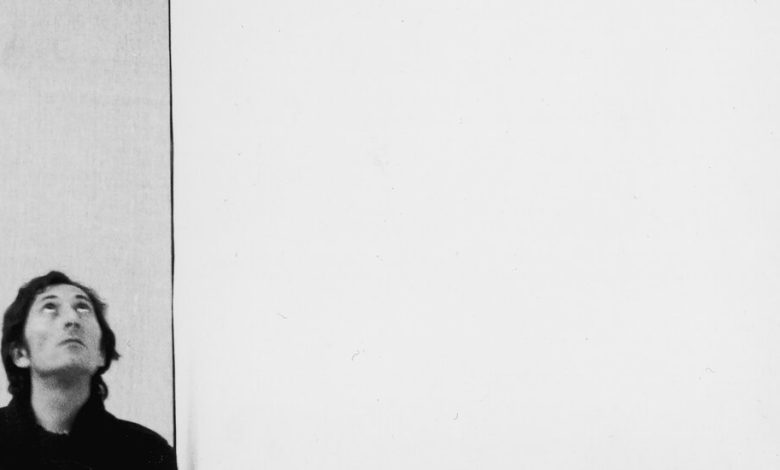Giovanni Anselmo, a Leader of the Arte Povera Movement, Dies at 89

Giovanni Anselmo, one of the funnier and more philosophical of the Italian artists making what the critic Germano Celant indelibly named Arte Povera, or “poor art,” died on Monday at his home in Turin, Italy. He was 89.
His death was announced by the Marian Goodman Gallery in New York, which represented him.
In 1967, Mr. Celant noticed that some members of the postwar generation of young artists were using humor, provocation and unconventional materials to rebel against both older artistic orthodoxies and materialist pop culture. He coined the term “arte povera” in connection with a show he curated in Genoa, which included the work of Jannis Kounellis, Alighiero Boetti and others. He then wrote a manifesto and began gathering other like-minded artists.
Mr. Anselmo, an early addition to the movement, was distinguished from his peers by his particularly thoughtful cast. His most famous work may have been “Senza Titolo (Struttura Che Mangia)” (“Untitled (Structure That Eats)”): two blocks of granite, bound together with copper wire and sandwiching a fresh head of lettuce. As the lettuce sagged, so did the smaller block, until finally the block fell and the greens had to be replaced — or not.
First shown in 1969, that sculpture exemplified a technique to which Mr. Anselmo would return often, and to great effect: juxtaposing two notionally opposed values — in this case, permanence and evanescence, or maybe gravity and whimsy — to reveal that they weren’t as distinct as they seemed. Even stone doesn’t last forever; on the other hand, so long as someone replaced the parts that wilted, the piece theoretically could.
His most elegant effort might have been “Particolare,” conceived in 1972 for a show at Galleria Gian Enzo Sperone in Turin. It consisted of one or more slide projectors projecting the word “particolare,” Italian for “detail,” in thick sans-serif letters. In one version, on permanent display at Magazzino Italian Art in Cold Spring, N.Y., a single projector sits on the floor, too far from the wall, so that the word becomes visible only when a visitor sticks a hand or leg into what appears to be simply a diffuse beam of light.
Mr. Anselmo’s favorite material was stone — sometimes chunks salvaged from construction sites in Turin, often large granite blocks. For “Direzione,” he embedded a compass in the surface of a granite wedge. In other works, he hung rocks from a wall using cables tied in slipknots, visually dissonant combinations of buoyancy and weight.
He also made use of piles of earth, photographs and reversed mirrors; the words “TUTTO,” or “everything,” and “INVISIBLE”; and the color ultramarine. Many works made reference to his own body — among them “Il Panorama fin Verso Oltramare” (“The View Up to What Lies Beyond the Sea”), an ultramarine stripe exactly the artist’s height painted above a block of granite, and a 1965 photographic self-portrait on which he drew two intersecting beams in pencil. That Mr. Anselmo included, or nodded at, himself in his work was an expression less of self-regard than of an almost scientific interest in the experience of being alive.
Reviewing a 1989 solo show for The New York Times, the critic Michael Brenson described Mr. Anselmo’s art as a commentary on the “paragone,” a Renaissance-era debate among Italian masters about the relative supremacy of sculpture and painting. He was making “works outside painting and sculpture that comment on both,” Mr. Brenson wrote, in order to “relieve the weight of his artistic past in ways that help that past remain alive.”
In “Torsion,” a four-and-a-half-foot cube of cement now in the collection of the Museum of Modern Art, a series of leather straps embedded in the work’s top surface wrap around a long wooden pole, which is braced against a wall. It’s hard not to imagine the pole swinging free, and in that sense one could almost call the piece a kinetic sculpture, if only in theory.
“It is Anselmo’s unique achievement to have fused perceivable and imperceivable realities within his art,” Anne Rorimer, a former curator at the Art Institute of Chicago who has lectured on Mr. Anselmo’s career, said in an interview.
Giovanni Anselmo, one of four children, was born on Aug. 5, 1934, in Borgofranco d’Ivrea, Italy. He spent most of his life in nearby Turin and later divided his time between there and Stromboli. Before turning to conceptual sculpture, he was a self-taught painter and worked as a graphic designer.
Mr. Anselmo had a wide-ranging and markedly successful career that included numerous international exhibitions and appearances at Documenta in Kassel, Germany, and at the Venice Biennale, where he won the Golden Lion Award in 1990.
He was represented by the Lia Rumma Gallery in Milan and, for nearly 40 years, by Marian Goodman. He had recently participated in a group show, with Giulio Paolini and Giuseppe Penone, that traveled from Paris to Milan. In October, his installation “Orizzonti” (“Horizons”), consisting of four blue lights that indicate the cardinal directions, opened in Piazza Carlo Alberto in Turin. A retrospective of his work at the Guggenheim Bilbao in Spain is planned for next year, as is a major Arte Povera show featuring his work, curated by Carolyn Christov-Bakargiev, at the Bourse de Commerce in Paris.
Survivors include his wife, Alda Anselmo; a sister, Sally Paola Anselmo; and a brother, Armando Anselmo.
Shortly before the end of his life, the usually very private Mr. Anselmo shared a childhood memory with Ms. Christov-Bakargiev.
During the Nazi occupation of northern Italy, when he was 10, he told her, he and his friends used to climb through the bars of an armory and steal ammunition to pass on to the partisans. When she asked how, at that age, he was able to distinguish the good guys from the bad guys, she said he told her it was easy.
“In the street, one group spoke very loudly and was scary,” she recalled him saying, “while the others spoke kindly and softly.”




